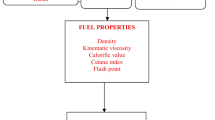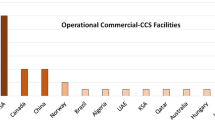Abstract
Prospects of the use of oil shale are associated with its thermal processing for the production of liquid fuel, shale oil. Gaseous by-products, such as low-calorie generator gas with a calorific value up to 4.3MJ/m3 or semicoke gas with a calorific value up to 56.57 MJ/m3, are generated depending on the oil shale processing method. The main methods of energy recovery from these gases are either their cofiring with oil shale in power boilers or firing only under gaseous conditions in reconstructed or specially designed for this fuel boilers. The possible use of gaseous products of oil shale processing in gas-turbine or gas-piston units is also considered. Experiments on the cofiring of oil shale gas and its gaseous processing products have been carried out on boilers BKZ-75-39FSl in Kohtla-Järve and on the boiler TP-101 of the Estonian power plant. The test results have shown that, in the case of cofiring, the concentration of sulfur oxides in exhaust gases does not exceed the level of existing values in the case of oil shale firing. The low-temperature corrosion rate does not change as compared to the firing of only oil shale, and, therefore, operation conditions of boiler back-end surfaces do not worsen. When implementing measures to reduce the generation of NO x , especially of flue gas recirculation, it has been possible to reduce the emissions of nitrogen oxides in the whole boiler. The operation experience of the reconstructed boilers BKZ-75-39FSl after their transfer to the firing of only gaseous products of oil shale processing is summarized. Concentrations of nitrogen and sulfur oxides in the combustion products of semicoke and generator gases are measured. Technical solutions that made it possible to minimize the damage to air heater pipes associated with the low-temperature sulfur corrosion are proposed and implemented. The technological measures for burners of new boilers that made it possible to burn gaseous products of oil shale processing with low emissions of nitrogen oxides are developed.
Similar content being viewed by others
References
A. Ots, Oil Shale Fuel Combustion (Tallinn, 2004) [in Estonian].
A. Raukas and A. Siirde, “New trends in Estonian oil shale industry,” Oil Shale 29 (3), 203–205 (2012).
V. T. Sidorkin, A. N. Tugov, V.M. Supranov, M. A. Izyumov, A. V. Sokolov, S. N. Kolesnik, V. N. Nikiforov, and K. G. Golub’, “Experience of exploitation of BKZ-75-39FSl boilers for shale treatment product incineration,” Energetik, No. 2, 68–70, (2014).
V. T. Sidorkin, A. N. Tugov, V. A. Vereshchetin, and D. A. Mel’nikov, “Assessment of combustion of oil shale refinery by–products in a TP–101 boiler,” Therm. Eng. 62 (4), 271–277 (2015). doi 10.1134/S0040363615040098
P. V. Roslyakov, I. V. Morozov, M. N. Zaichenko, and V. T. Sidorkin, “Digital studies of low–emission burner devices for semi–coke gas incineration in energetic boiler,” Therm. Eng. 63 (2016). doi 10.7868/S0040363616040068, (in press). 10.7868/S0040363616040068
V. T. Sidorkin, A. N. Tugov, D. A. Moshnikov, V. A. Vereshchetin, and K. G. Bersenev, “Effect of flue gas recirculation on the boiler operation and its emission rate,” Elektrich. Stantsii, No. 7, 27–31 (2015).
P. V. Roslyakov, R. Attikas, and M. N. Zaichenko, “Studying of the possibility of separate and joint combustion of Estonian shales and oil shale retort gas at thermal power plants,” Therm. Eng. 62 (10), 691–702 (2015). doi 10.1134/S0040363615100082
A. Ots, A. Poobus, and T. Lausmaa, “Technical and ecological aspects of shale oil and power cogeneration,” Oil Shale 28 (1S), 101–112 (2011).
SO 153-34.02.304-2003. Methodical Directions on Calculation of Nitrogen Oxide Ejections with Flue Gases of Thermal Power Station Boilers (OAO VTI, Moscow, 2005) [in Russian].
Author information
Authors and Affiliations
Corresponding author
Additional information
Original Russian Text © A.N. Tugov, A. Ots, A. Siirde, V.T. Sidorkin, G.A. Ryabov, 2016, published in Teploenergetika.
Rights and permissions
About this article
Cite this article
Tugov, A.N., Ots, A., Siirde, A. et al. Development of measures to improve technologies of energy recovery from gaseous wastes of oil shale processing. Therm. Eng. 63, 430–438 (2016). https://doi.org/10.1134/S0040601516060082
Published:
Issue Date:
DOI: https://doi.org/10.1134/S0040601516060082




